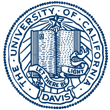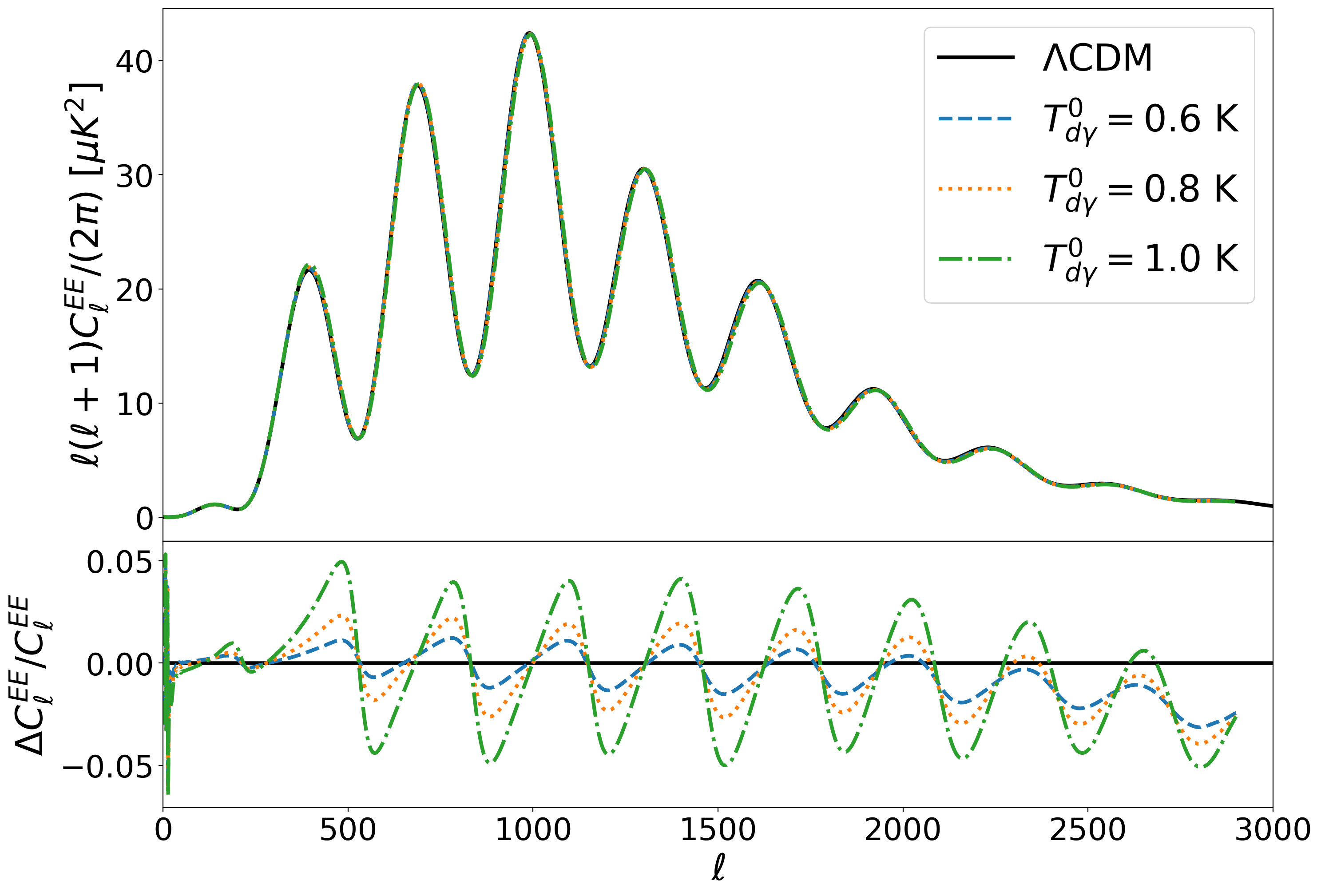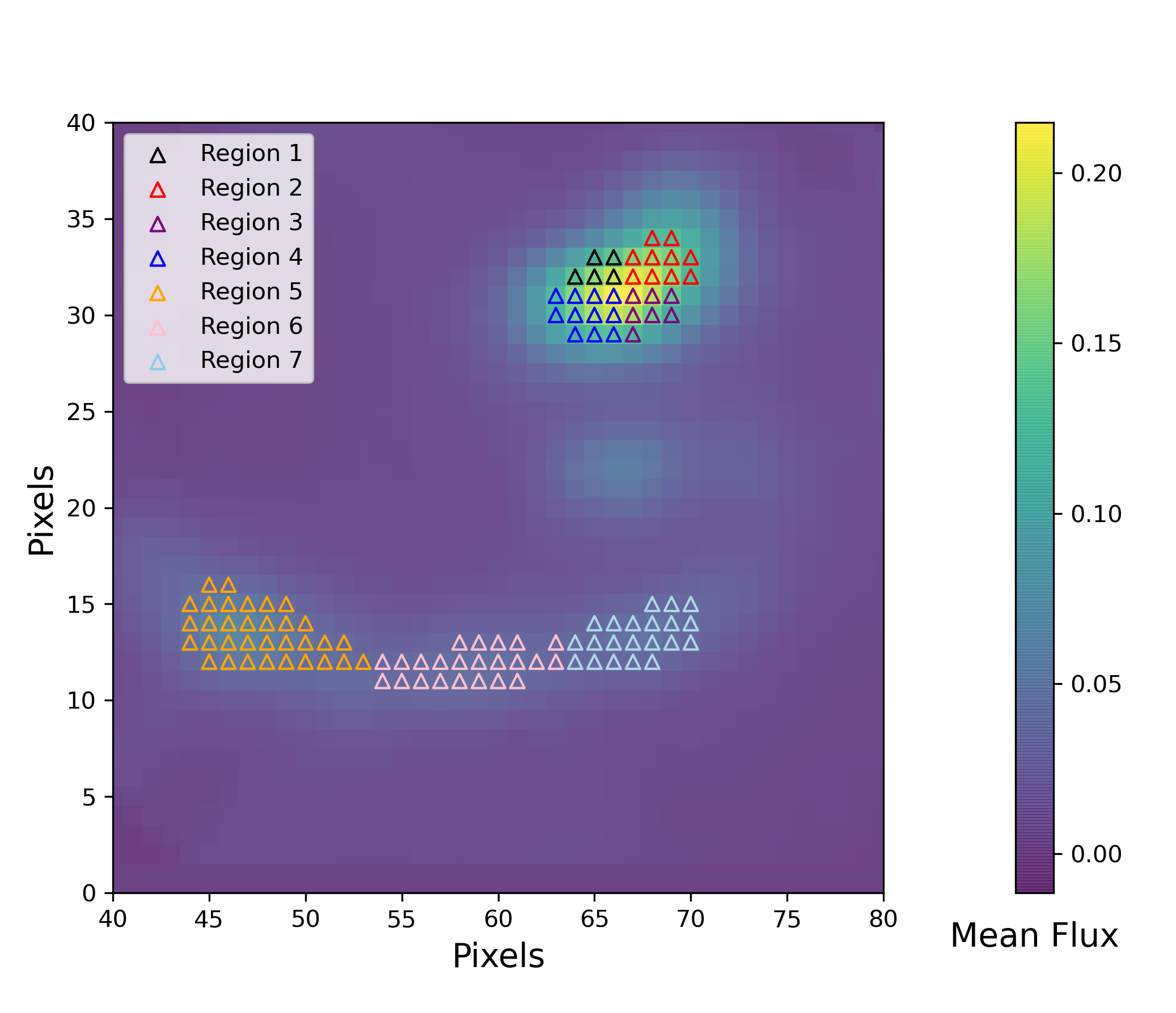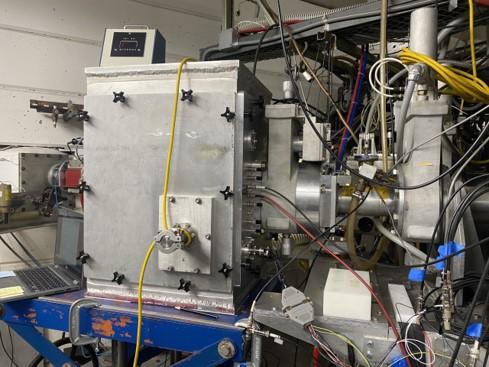
This REU program was funded through NSF PHY-2150515.

Several models for the power spectrum of the cosmic microwave background (CMB) radiation give nearly identical results, although the bottom trace shows their slight differences. Thanks to high-precision CMB data sets and their amazing agreement with theory, these tiny discrepancies are at the level of current research. See Ellie Hughes' paper to learn more.
Students' names link to their final papers. Advisors' names link to the research group web pages.
Condensed Matter Theory
Real materials are incredibly complicated; a cubic centimeter of a solid contains about Avogadro's number of atoms. When some electrons dissociate from the atoms and interact with each other and the resulting ions, it's impossible to calculate exactly what happens. Instead, condensed matter theorists explore simplified models that can capture key aspects of the physical behavior. Claire Kvande (Kalamazoo College; advisor Richard Scalettar) explored one example, the Holstein model. By using a double-well potential, she found that adjusting parameters could change the temperature onset of charge density waves. Hence the model may be able to give new insight into the conditions for charge density wave formation.
A spin glass consists of magnetic moments with interactions that prevent any long-range order; for example, the moments cannot all be aligned in the same direction, they cannot alternate in direction, etc. Instead the moments seem randomly oriented, although they can move only slowly, like atoms in a glass. A quantum spin glass has the further requirement that there is a large amount of entanglement among the spins, meaning that there is no simple way to describe the position of one spin separately from that of the others. Tao You (Middlebury College; advisor Rajiv Singh) carried out exact calculations for quantum spin glasses with small numbers of sites. He used spin-1/2 particles on a two-dimensional lattice. The spins align perpendicular to the plane of the lattice, and there is an additional magnetic field in the plane. His results showed similar behavior to predictions obtained by expansion techniques in large systems.
Condensed Matter Experiment
Rose Albu Mustaf (University of La Verne; advisor Inna Vishik) measured non-equilibrium behavior in TaS1.5Se0.5, a material with potential applications in electronics. On cooling from room temperature, it has a phase transition from metallic to insulating near 180 K. Applying a first laser pulse excites some of the electrons in the material and changes its reflectivity, which can be measured using a second pulse. Repeating these two-pulse measurements, with different time intervals between the pulses, shows how quickly the system returns to equilibrium. To make the timing precise enough, a single laser beam is split. The resulting beams follow paths of different length to the sample, hence arriving at different but closely spaced times. The image below shows the table of mirrors needed to arrange this. Rose measured the relaxation as a function of temperature, in both the metal and insulating phases. She found hysteresis, where the relaxation time at certain temperatures depended on the history of whether the temperature had been reached by warming or by cooling. Work is continuing on relating the hysteresis to other properties of the material.

For several decades after the BCS theory of superconductivity was formulated in the 1950's, people believed that magnetic fields and even magnetic impurities would destroy superconductivity. More recent discoveries show that the situation is far more complicated. Many materials require magnetism as part of the mechanism for superconductivity, and some include magnetic atoms in their crystal structure. Henry Bowman (Carleton College; advisor Valentin Taufour) studied LaNiGa2, a new material which may have internal magnetic fields concurrently with superconductivity. Henry worked on growing single crystals, aligning multiple crystals to create a target large enough for muon spin resonance experiments, and measuring resistivity. Resistivity differed significantly among samples, which may be from highly anisotropic behavior or from high sensitivity to impurities. The muon spin resonance experiment, a decisive means of testing for internal magnetic fields, will be done by a collaborating group but had not been completed by the end of the summer.
Mackenzie Cassell (Solano Community College; advisor Rena Zieve) helped design the mechanical structure for a superfluid helium experiment. The measurement aims to mimic features of a neutron star's rotation with a bucket of superfluid helium. The probe must be free to levitate and rotate, but it also has to be lowered into superfluid helium for filling the bucket. Other constraints involve the locations of parts needed for levitating, rotating, and monitoring the rotation speed. Finally, all manipulations must be possible without visual cues, since they will ultimately be done inside an opaque dewar. Mack worked on preliminary designs and then on debugging when issues became apparent during construction.
Pedro de Oliveira (Cornell University; advisor Dong Yu) studied the motion of ions in hybrid organic/inorganic photovoltaics. This ionic motion may explain the observed hysteresis which hampers the material's potential for certain applications. Pedro used scanning photocurrent microscopy, noting the electrical current resulting from illuminating different spots on the sample with a laser. His results suggested motion of ions perpendicular to the nominal electric field direction, perhaps because of inhomogeneous field distribution. By measuring as a function of temperature, he also estimated the activation energy for the ionic motion, finding a good match with theoretical values. The images below convey some of the experimental difficulty. On the left is a collection of the tiny samples to be measured. On the right, a single sample has been positioned in contact with the electrical leads (horizontal lines).

Dhan Bautista (CSU Fresno; advisor Nicholas Curro) studied the nuclear magnetic resonance properties of the iron-based superconductor CaKFe4As4. This material becomes superconducting at 35 K, and exhibits an unusual antiferromagnetic structure when doped with Co. Dhan investigated the spin lattice relaxation rate and spectra of the As-75 nuclear spins in this material as a function of temperature. In order to study how the low temperature properties might change in the presence of a symmetry-breaking strain field, he also mounted a crystal that was specifically cut using a Xe-based focused ion beam into a device for applying uniaxial strain, and observed how the NMR spectra changed in response.
Daniel Pardo (University of Notre Dame; advisor Shirley Chiang) worked on characterizing lead (Pb) atoms on particular crystal surfaces of germanium (Ge). These surface studies involved images from a scanning tunneling microscope (STM) and a low energy electron microscope (LEEM), both of which are described in Daniel's write-up. Previous work showed that Pb gathered into islands of a characteristic height, which varied with temperature. The height had previously been inferred from LEEM measurements, but Daniel hoped to get better height data with STM and to compare the two methods. Difficulties with the instruments, which could not be fixed within ten weeks, did not allow the planned measurements, although he did take some relevant LEEM images.
Astrophysics and Cosmology
Present measurements of the cosmic microwave background (CMB) are in excellent agreement with theoretical calculations. The precision of the measurements means that even small deviations from theory are potential clues that the theory needs an additional term or some other tweak. Ellie Hughes (Bryn Mawr College; advisor Lloyd Knox) checked how dark matter particles from a particular model might impact the theoretical predictions of the CMB power spectrum. She found that the CMB data are consistent with the dark matter model, although they do not require it. One unexpected result was that the dark matter parameters that matched CMB extended into a range that previous work seemed to have ruled out; more study will be done on this.
Chaucer Langbert (Wellesley College; advisor Matt Richter) ran calculations for a potential successor to the James Webb Space Telescope. A large number of planets beyond our solar system, or exoplanets, have now been discovered. People would like to explore the planetary atomspheres, searching particularly for molecules related to life. As the planet orbits its star, its velocity alters the Doppler shift of its spectrum. The periodically varying Doppler shift has been a key method of detecting exoplanets, and it can also be used to separate the planetary spectrum from the star's much brighter signals. Chaucer performed these calculations with simulated data, with encouraging results for the ability of the new satellite to measure planetary atmospheres.

An important feature of our universe is the distribution of matter. On different length scales visible matter clumps into planets, galaxies, and galaxy clusters. Dark matter also has a non-uniform distribution, which can in turn influence the distribution of visible matter. However, pressure effects can smooth out the visible matter relative to the dark matter. Madisyn Brooks (University of Central Florida; advisor Tucker Jones) studied this behavior in the gas of the intergalactic medium, which is the region between galaxies. She looked at gravitationally lensed images, where the light had bent in passing near a heavy object. The bending expands the image in one direction, which makes possible finer length resolution along that direction. The image above shows two arcs where gravitational lensing has distorted what would otherwise be a circular feature; the lower one is especially elongated. Madisyn found that for the system she examined, the intergalactic medium is in fact smooth on the expected length scale.
Because of the expansion of the universe, astronomers can study different times by looking at galaxies different distances from Earth. Unfortunately, very distant galaxies, several billion light years away, are too faint for current instruments. Another approach to probing such early times is to observe nearby galaxies, then try to de-age them, projecting them back in time billions of years. Heather Pearson (Oberlin College; advisor Andrew Wetzel) tested a part of this procedure, namely the practice of limiting the sample of nearby galaxies to a particular region. She used data from a simulated universe to check whether the typical "near" region is adequately representative. She found that it is, at least as regards the mass distribution of the sampled galaxies.
Particle Theory
In quantum mechanics and field theory, systems are described by a Hamiltonian matrix. "Solving" the system involves diagonalizing the Hamiltonian to determine its eigenvalues (energies) and corresponding eigenvectors. Since the Hamiltonian is often an infinite-dimensional matrix, full diagonalization is often impossible. One way to reduce the complexity of the problem, and thereby make it more practical to carry out relevant computational work, is simply to discard part of the matrix. Chester Mantel (University of Oregon; advisor Markus Luty) looked into Hamiltonian truncation, which retains only the states below a certain energy. He worked on a way to implement this truncation and construct the resulting approximate (but finite!) Hamiltonian.
Particle Experiment


Sarah Hawkins (College of William and Mary; advisor Eric Prebys) worked at the cyclotron at Crocker Nuclear Laboratory, next to the Physics Building. She measured nuclear cross sections for various isotopes, particularly some that have medical applications and others that are produced during the same process as the medical isotopes. This is important information for optimizing production of the useful isotopes and also for determining possible side effects if any of the concurrent isotopes are harmful. Sarah helped set up a vacuum chamber for the irradiation, as a way to improve measurement precision. The measurement itself consisted of irradiating a stack of tantalum foils with protons and measuring its subsequent emission of gamma rays. Sarah then analyzed the data to determine the cross sections. The images above show her vacuum box connected to the beam line, with the side door in place (left) and open (right).
High-Energy Nuclear Experiment
At Brookhaven National Laboratory and CERN, gold or lead ions can be accelerated to near the speed of light and then collided with each other or with stationary targets. The many nucleons then undergo a large number of interactions, which at first are so energetic that they can create new particles. The interaction region expands, and hence cools, until particle creation is no longer possible. Cade Rodgers (University of North Carolina; advisors Daniel Cebra and Manuel Calderon de la Barca Sanchez) compared accelerator data to Monte Carlo simulations to determine this final size and shape of the interaction region, both perpendicular and parallel to the initial ion velocity. The particles present once creation ceases are those detected from the collision, so Cade's work can help match the observed tracks to the situation during and just after the collision.